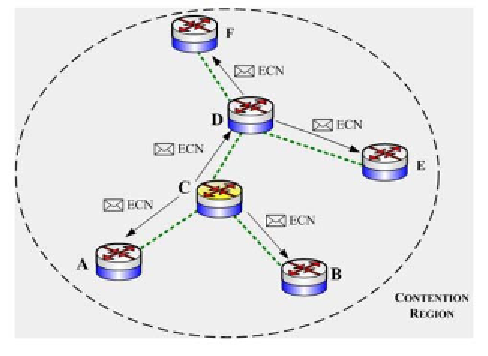Information Technology Reference
In-Depth Information
Figure 5. Explicit Contention Notification Scheme
e. Local Time Synchronization
802.11 (IEEE 802.11 Working Group, 1997).
The performance evaluation in our simulation
is achieved through a set of tests which allows
making comparison with other MAC protocols,
and it takes the following aspects: The impact
of the hybrid scheme and channel diversity on
network throughput.
The protocol adopts the same synchronization
technique used in Z-MAC. The advantage of such
technique is that synchronization is required only
among neighboring senders and also when they
are under high contention. These points offer an
excellent opportunity to optimize the overhead of
clock synchronization because synchronization is
required only locally among neighboring senders.
In addition, the frequency of synchronization can
be adjusted according to the transmission rates
of senders so that senders with higher data rates
transmit more frequent synchronization messages.
In this scheme, receivers synchronize passively
their clocks to the senders' clocks and do not have
to send any synchronization messages.
HYBRID SCHEME EVALUATION
In this simulation, we have chosen to make a com-
parison between H-MAC, Z-MAC, and 802.11
MAC protocol. We have measured and compared
the effective channel utilization of H-MAC and
Z-MAC. For this purpose, we have repeated the
same simulation and used the default settings of
Z-MAC as described in (Rhee, Warrier, Aia, and
Min, 2005). We varied the backoff window sizes
to see the impact of window sizes on channel
utilization. We used three scenarios in our simula-
tion: one-hop, two-hop and multi-hop scenarios.
One-hop scenario
: in this scenario 21 nodes
are placed equidistant from a receiver in a circle
(Figure 6). Before each run, we ensured that all
nodes are in a one-hop distance to each other so
that there are no hidden terminals. This scenario
is used to measure the achievable throughput of
PERFORMANCE EVALUATION
We have implemented H-MAC using the network
simulator ns-2 (Fall and Vradhan, 1998) and
compared its performance with the existing MAC
protocols. In fact, we compared the performance
of H-MAC with Z-MAC (Rhee, Warrier, Aia, and
Min, 2005), MMAC (So and Vaidya, 2004), LCM-
MAC (Maheshwari, Gupta and Samir, 2006), and

Search WWH ::

Custom Search